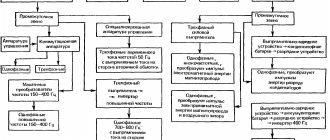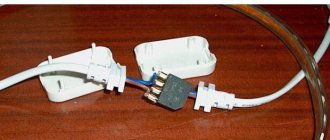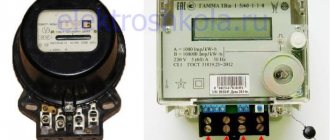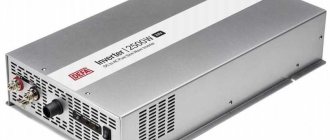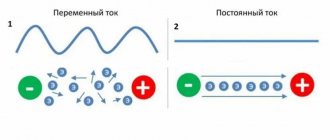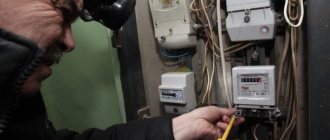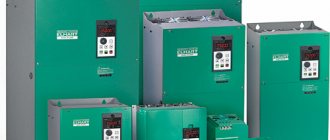Basic rules for using Vago
1. For lighting and other circuits limited in current to 10A, the terminals are excellent; you don’t need to know any subtleties. Connected - and let's go!
2. If the current is from 10 to 20 A, you need to think about the cleanliness of the surface of the wires. Moreover, the current must really be limited by the corresponding circuit breaker (10, 13, 16, 20 A), and the wire must have a cross-section of 1.5 or 2.5 mm². Otherwise it might look something like this:
The Vago 773 terminal block with the paste burned out because... the old aluminum wire was not stripped
3. At currents of 25 A or more, I would limit the use of Vago by moving on to crimping, welding or soldering wires. Although, for quick repairs of home electrical wiring, there are no better or more convenient methods than Vago.
Personal experience using the Wago terminal block
I did an experiment at home. In a junction box , which is all on an aluminum wire from the developer. Poe bit off the aluminum and assembled everything on Wago terminals.
The input wires that powered the wiring from the shield were placed on separate “vags” and lined with copper. And this is what happened:
Aluminum wire with a cross-section of 1.5 square millimeters and copper 2.5 square, through the wago terminal block. Black with a graphite-solidol thing inside. It seems like the reliability is almost durable, however.
All this is a violation of “PEU”. It worked for 3-4 years and soldering stations, vacuum cleaners, and soldering hair dryers were used with a bang, no complaints. But when I started running a washing machine from the same line, miracles began to happen. Literally, in a month, after 6-8 washes as usual. The junction box: began to sing, groan, characteristically spark and show signs of instability. Several times even the surge protector went into protection (I have it with surge protection).
The alarm for burning and sparking of the wiring on the Wago terminal blocks rang, I climbed inside and what did I see?
The darkness and trash of this junction box reflects the general standard of living)
The same wago terminal block that leaked but continued to work
Copper to aluminum connection Wago terminal block
BINGO! Everything melted to hell! The whole point is that the connection: copper with aluminum - does not heat up so much under the load of current passing through this connection. As a result, it is clear that the wago terminal blocks have been smashed into mush. Moreover, the copper wire is stuck, and the aluminum dangles like a hair. Of course, the “zero” burned out, but the phase contact also melted.
How to use Wago 773 terminals at high currents
If I need reliable operation of the Vago 773 connecting terminals at maximum currents (up to 25A), I recommend using the method - strip the wires by 20-30 mm, connect them using the connecting terminal as usual, and twist and insulate the remaining bare parts.
Strengthening Wago 773. Insert the wires
Strengthening Wago. Now we twist it. You can rest assured about contact.
We isolate and quietly seal the contact, its reliability has increased many times over.
Attention! All connection points must be accessible!
How to use Vago 222 terminals correctly
The main thing is to understand that one terminal block is one electrical contact.
How to properly connect Vago 222 clamps
How to properly connect Vago_larger clamps
Now let’s move on from general cases to an analysis of the practical application of these wonderful terminal blocks.
Example 1. How to use Wago 222 terminal blocks
The example shows how easy it is to put things in order in a control panel with automatic machines, where it is a mess, very crowded, there are different wires, and you need to connect more. There is no photo of what was originally, but it may be good. I will consider both the pros and cons.
In the utility room, where everything is made with corrugation, you need to install and connect an additional plastic panel with 4 circuit breakers. Moreover, it must be connected to the existing panel, minimally interfering with it.
It’s correct to say “plastic modular housing”, but I say “shield”, it’s simpler and clearer.
Here is the old panel to which you will connect.
Old electrical panel assembled
What is the main problem with such shields (pictured)? Despite the fact that it is positioned as a housing for 4 circuit breakers (4 modules), 4 circuit breakers fit into it with great difficulty. After all, you still need to connect zeros and grounds. And these are two more terminal blocks. Therefore, you should always leave approximately 20-30% of free space in the shield as a reserve.
The wires of zeros and grounds were connected to plastic terminal blocks with a screw (Lego type), without lugs. And where should I go with my rigid single-core VVG 3x2.5?
Fortunately, German engineers came up with universal clamps Wago 222 , which helped me out. This is how I installed the connections.
An old shield with the cover removed. The wires are connected through Vago clamps
Participating in the connection: multi-core PVA wires with a cross-section of 2.5 (input from the top) and 1.5 mm and single-core VVG 2.5 mm (this goes to my panel, bottom left). If there is another way to connect in this situation, write in the comments.
My shield is installed below, and the connections in it now look like this:
New electrical panel with connections via Wago clamps
Please note, this is important - I chose a panel with 6 modules to install 4 machine modules. There are 3 reasons for this:
- Space for laying wires, you can leave a small margin;
- There is somewhere to place the clamps (terminals), you can put the terminals on a DIN rail;
- For the future, if you need to connect another consumer (not two!), there will be somewhere to install an additional machine.
Close the shield.
New shield assembled. Room sockets, utility room sockets, lighting, boiler.
This is what both shields look like. All the work on installing the panel, automatic devices, connecting wires, laying 4 cables in three corrugations took no more than an hour.
Result - both shields are assembled
The main thing is that the current is limited by the machine to 25 A, the wires are all copper and new, heating will be minimal.
The disadvantage of using Wago 222 connecting terminals this way is that if there is a possible overcurrent, the terminals may begin to melt. Therefore, for peace of mind, it is better to reduce the ratings of circuit breakers.
Original WAGO terminal block
Almost any electrical circuit requires connections between two or more wires. Many craftsmen to this day rely on the time-tested method of creating reliable contact - twisting. In order for the unit to serve for a long time, it is additionally completely isolated from the effects of oxygen and moisture on the exposed wires.
Other equally common options:
- Sleeve . Inside the metal cylinder there is a special lubricant that performs the task of an insulator. Contacts are crimped using pliers, which is not always convenient in cramped conditions.
- Welding . The most effective and most reliable way to form a contact, since as a result the metal cores become a single whole. To operate, a special device powered by mains or battery is required.
- Soldering . In terms of reliability, it is slightly inferior to a welded joint; the technique is more often used together with an installed sleeve. The disadvantage is the relatively low melting point of the solder. The work is done using a soldering iron.
Connecting wires using a soldering iron Source forum.cxem.net
- Bolts . The relevance of connecting wires through a washer applies mostly to the transition from aluminum to copper. This is a practical connection, but weakens over time.
- Terminals . A universal option for quickly forming a contact.
A miniature device means a connecting element that is designed for switching electrical wires. Today, almost any compact product of this kind is classified as Vago clamps. However, in fact, WAGO is a German brand under which electrical devices have been produced for more than half a century.
Arrangement of switching devices
Inside the plastic case there is a metal plate that acts as a spring mechanism for fixing the conductors. The element mechanically affects the metal, but does not change its shape, and is chemically inert to copper and aluminum. The clamping force ensures reliable contact between the wires and creates little resistance.
Reusable terminal Source yandex.net
To manufacture the current-carrying rail, electrolytic copper with a soft tinned surface is used. The workpiece is coated with an alloy that contains tin and lead (60 and 40%, respectively). This protective film is needed to prevent corrosion processes.
The spring part is made of chrome-nickel steel, which is characterized by high tensile strength. To insulate the clamping mechanism, a polyamide housing is cast. The material is characterized by inertness to rust, self-extinguishing ability and low flammability.
The clamping mechanism can be made in three versions:
- leaf spring;
- Flat Cage Clamp;
- Fit Clamp is designed so that the wire is clamped using a mortise contact.
The latter are less commonly used in the private sector due to their high cost compared to also reliable analogues. Here, a characteristic feature is the installation method - without first exposing the conductor. Such devices are relevant when it is necessary to quickly connect wires or in large quantities.
Insulated wire clamp Source asset.conrad.com
See also: Catalog of companies that specialize in electrical work of any complexity
Pros and cons of using terminal blocks
Terminals are used to create a permanent or temporary connection of low-current wires with one or more cores. The main advantages of using WAGO wire clamps, which experts highlight, look like this:
- diversity within the group, which eliminates the search for alternative options;
- simple installation without the use of specialized tools;
- rapid formation of high-quality, reliable, insulated contact between the cores (there are samples for connecting dissimilar wires);
- safe use, all requirements for contact connections in the electrical network are taken into account;
- accessibility relative to cost, you can find the necessary option in almost any locality.
However, price also stands out as a disadvantage of analog products. When installation work is limited to a local area in the circuit, the estimate increases slightly taking into account the clamps.
Using terminals to connect a chandelier Source sztuka-wnetrza.pl
To service a large facility or completely replace the wiring in an apartment, a more significant amount is required, since there are many contact nodes in the network.
Another drawback is the possibility of the plastic case melting or catching fire. But in relation to the original Vago terminal blocks, such a statement does not apply. The main thing here is to comply with the technological requirements for the installation and operation of products (cross-sectional area and composition of the conductor, expected network voltage at the contact being made).
Technically, analogue products are characterized as follows:
- permissible core cross-section – 0.08-95 sq. mm;
- mains voltage – 100-1000 Volts;
- current strength – 6-323 Ampere;
- operating temperature limits – from -35 to +170-200 degrees Celsius.
Today in the construction market, especially in online stores, Chinese-made products under the same brand are often found. These are cheap analogs of German WAGO wire connectors, which are similar in appearance and design, but differ in the quality of the materials used.
Original WAGO terminal blocks Source sklad-max.ru
Distinctive features of the original terminals are:
- markings on the back of the case;
- a diagram and limits are drawn for the exposed section of the core;
- color indication of external elements of the product;
- thickened strips to ensure reliable contact between wires;
- There is no magnetic field in the area of metal parts.
Fake terminals are distinguished by the color of the plastic housing and levers, which may also emit an unpleasant odor. The brand name and markings are applied differently, and some information is completely missing. Metal elements are thin and often magnetized.
Example 2: Using Wago terminals to repair electrical wiring
The following example shows how to quickly repair electrical wiring that has been broken with a literal axe. The man tried to twist something himself, set up a short circuit in the house, and then called me:
Quick repair of wiring to an outlet. This is what we have today (C)
Here's how I carried out a quick electrical wiring repair using Wago 773 connecting terminals:
Quick repair of wiring to an outlet using Vago disposable terminals
The phase is wrapped with black electrical tape. Then you need to turn off the electricity, carefully hollow out a place for new connections, and plaster over the whole mess. It is better to insulate the places where the wires enter the terminals with electrical tape before doing this.
How to install a socket in such socket boxes is described in detail in my articles about how to reliably install a socket here and here. Be sure to read!
Example 3. Repair of distribution unit
In this (I don’t dare call it a box) ... This box of wires has everything - the input from the entrance (wires thinner than one and a half rubles, turning into aluminum, turning into a ball-and-socket screw with single-layer insulation, and rigid wires, and flexible wires, and copper, and luminium.
How did it work? Don't know. The owner called me when he himself caused a short circuit, and the floor of the apartment was left without voltage. At the same time, the entrance Soviet machine gun 25A did not work, which is natural.
I temporarily restored the power (the wires were burned out) by using two Vagos (222 and 773, can be seen at the top of the photo):
Repair of old aluminum electrical wiring. The worst thing is that people lived with this for many years, it was simply covered with plaster, and the machine was set to 25A!
A couple of days later I came again, first threw out everything unnecessary, and figured out what came from where and where. I also threw out the wires from the entrance, I will lay new ones later:
Repair of old aluminum electrical wiring. On the left there are wires - light for the toilet and power supply for the entire apartment. Down – toilet and bathroom switch. On the right is the bathroom light and kitchen power.
Now, using pieces of hard copper wire and Vago terminal blocks for different numbers and different types of wires, I assemble a circuit:
Repair of old aluminum electrical wiring. The VVG3x2.5 cable from the entrance comes from below. Wago 222, Wago 773 with and without paste were used.
Here's what we ended up with:
Repair of old aluminum electrical wiring. Vago helps out great!
Of course, if you do everything wisely, you need to completely change the wiring in the entire apartment. But such a task was not before me.
I am calm about my work and this apartment, especially considering that it is now powered through a 16A circuit breaker. And the most powerful consumers are the washing machine and refrigerator.
Twists, terminal blocks and WAGO
In light of the recent discussion, there is a need to take measurements and obtain a numerical answer to the question: which is better? WAGO, screw terminals or copper and aluminum strands?
Samples
The following were included in the study:
- terminal block TV-2504L 25 A (manufacturer not specified)
- terminal block TV-1504L 15 A (manufacturer not specified)
- WAGO 222 20 A (gray)
- WAGO 221 20 A (transparent)
- twist (slightly less than 20 mm wire)
- “polyethylene” terminal block 5 A (not shown in the photo)
- whole wire
- twisting of copper with aluminum
- twisting aluminum to aluminum
In all cases, single-core copper wire with a nominal cross-section of 2.5 sq. mm and an actual cross-section of 2.3 sq. mm is used.
Yes, copper in wires is often not reported (I will not indicate what such people should be called). The shortage was identified by both measuring the diameter and resistance of the wire. A cross-section of 2.5 sq. mm was chosen because, based on the inscriptions on the WAGO body, this is the only cross-section supported by the terminal.
1.5 sq. mm - too thin - 1.4 mm diameter. 4 sq. mm - too thick - 2.3 mm. This limitation is additionally disappointing because, according to Table 1.3.4 of the PUE, the maximum current for a two-wire 2.5 sq. mm is 25 A, and the terminal is only 20 A.
There was a problem with the aluminum wire. The available wire with a cross-section of 6.1 sq. mm is not equivalent to copper 2.5 sq. mm in terms of current load (Tables 1.3.4 and 1.3.5 PUE), which makes direct comparison impossible. For this reason, the measurement results are not included in the final table. But it's not scary. In any case, the purpose of the experiment was to test copper connections, and aluminum strands were added as shock content.
TV terminal blocks are used in two ways: through - the wires are clamped on different sides and joint - both wires are under one washer, but without direct contact.
Resistance
The easiest way to characterize the quality of an electrical connection is by its contact resistance. To determine this, the following “installation” was assembled:
Here you can see the “polyethylene” terminal block that is missing in the first photo.
The connection resistance is determined by passing a current of 2.5 A and measuring the voltage drop. To connect a voltmeter, cuts are made in the insulation at a distance of 5 cm from the wire inputs to the terminal blocks. Further, in accordance with Ohm's law R=U/2.5.
For comparison, the resistance of an entire 12 cm long wire was measured (between the voltmeter connection points).
Heat
To check the behavior of the connections under practical conditions, the temperature rise above the environment was measured after a three-hour stay under a current of 15.5 A. The measurement was carried out with a thermocouple pressed to the wire core at the entry point into the terminal block.
Since WAGO's wire insulation is inserted into special recesses, the measurement was carried out inside the housing. The twist, for plausibility, was wrapped in blue electrical tape - the temperature was measured under the electrical tape. The “polyethylene” terminal block appeared after disassembling the installation and was also not included in the experiment.
Installation diagram:
If you look closely, you can see that the entire circuit is one short circuit plugged into an outlet. But the low output voltage (0.4 V) and the parasitic resistance of the transformer windings limit the current to less than rated values.
Practical implementation of the scheme:
Note the pile of burnt fuses.
results
| R, mOhm | T | |
| TV-25 direct | 1,3 | +10º |
| TV-25 nearby | 1,0 | + 9º |
| TV-15 direct | 1,3 | +11º |
| TV-15 nearby | 1,0 | +11º |
| WAGO 222 (gray) | 1,4 | +11º |
| WAGO 221 (transparent) | 1,4 | +12º |
| twist | 1,1 | + 9º |
| "polyethylene" | 1,2 | — |
| the wire | 1,0 | +10º |
| soldering | 0,9 | — |
The temperature difference is at the limit of the thermometer resolution (1º) and depends little on the contact resistance.
The latter indicates that it is mainly the wires that are heating up, and not the contact points. It seems that large terminal blocks (and twists) cool the contact point. At a current of 15 A, there is no significant difference between the connection methods.
All specimens are placed for storage in a flower pot (without soil) on the balcony, where it can be not only damp, but also wet, the daily temperature difference is about 30º, and the annual temperature difference is 70º. If I don’t forget in a year, I will explore the issue of weakening contact over time.
Addendum: WAGO section markings
Upon closer inspection, it was discovered that the statement that it only supports 2.5 sq. mm is not correct.
Taking into account some contradictions between the inscriptions on the case (“Cu 1.6/2⌀ 24-12AWG”) and the information on the website, the supported range is 0.2..2.5 (4?) sq.mm.
Addition: WAGO current markings
Two currents are specified: 20 A per UL 1059 and 32 A per IEC 60664-1.
UL 1059 is a standard for terminal blocks. A heating test technique is described to determine the rated current. IEC (GOST R) 60664-1 - insulation standard - does not contain guidelines for determining the rated current.
Addition: Soldering
The wires are soldered over a length of 25 mm. No twisting. No direct copper contact.
Resistance is 0.9 mOhm, which is less than that of a whole wire.
Example 4. Wago terminal blocks: how to use when installing a new junction box
I’ll give you an example of how I make connections in a distribution box when installing new electrical wiring.
Here's a cheap option. This is the hallway. Through a 20A machine, a cable with wires with a cross-section of 2.5 mm² comes into the box, and diverges into 1 socket (2.5 mm²), lighting and a bell (1.5 mm²).
Initially, after the plasterers, we have this:
Connecting wires in a new junction box. Let's sign the wires. On the left, a VVG2x1.5 cable for the bell sticks out of the wall. Guess through which terminals I will connect it)?
We strip the wires and determine where we have what. As usual - white phase, blue zero, yellow-green - ground. For switches - white phase, blue first key, yellow-green - second.
Connecting wires in a new junction box. wires are stripped, targets are identified
Connecting wires in a new junction box. The stripped wires are ready for connection.
3-5 minutes - and you're done:
Connecting wires in a new junction box via Vago 773
Close the box with a lid
Now you can plaster and paint or wallpaper. It is important that there must be access to the box, or at least its location must be known. Who knows what could happen in 20-30 years?
Don't forget to check everything!
Review of popular types of terminal blocks
There are several classifications of Vago terminals. They can be grouped by size, purpose, method and place of application. But the most convenient division into categories is considered to be a combined classification, which takes into account both functionality and installation location.
Let's consider the main groups of terminal blocks used for the electrical network. We will not consider terminal blocks with a choke, a capacitor, as well as for transformers and printed circuit boards due to their rare use in domestic conditions.
Category #1 - for lighting equipment
The category includes several types of products designed for connecting spotlights, sconces, chandeliers and other lighting equipment.
Kinds:
- Series 294 and 294 Linect® are used for switching fine-core, single-core and stranded wires without prior preparation. A special plate can be used to relieve tension. Maximum current – 24 A.
- The 272 series for wires with a cross-section of 2.5 mm² is divided into insulated and compact terminals.
- The 293 series is distinguished by having a direct ground contact and a snap-on mounting foot.
The advantage of this category is the development of Push-in CAGE CLAMP , thanks to which there is no need to put lugs on the wires or seal them before installation.
Optionally, a PE earthing contact can be installed directly below the wire connection so that the metal housing can be integrated into the protection system
On one side there is a hole for connecting a third contact with a cross-section of 0.5-0.75 mm².
Category #2 - for electrical installation work
This is the largest and most popular group, since the universal devices presented in it can be useful at any stage of arranging an electrical network.
The basic principle of connecting conductors is the abandonment of screw contacts and the use of spring clamping mechanisms.
Kinds:
- Series 224 is a specially designed device for connecting a single-core conductor to a thin stranded one.
- Series 243 - for servicing low-voltage systems that use 1-core wires of small cross-section - 0.6-0.8 mm.
- Series 2273 are compact yet powerful devices for saving space in junction boxes.
- Series 273/773 – for 1-core conductors 2.5 mm² and 4 mm². Recognized as the best-selling in the world.
- Series 222 are universal devices for all types of conductors, withstanding even high currents.
- Series 221 is an improved version of the 222 series with a transparent compact case.
Products of the 221 series are especially popular in Russia. Due to their reduced size, they are often used where space is limited, for example when many connections need to be squeezed into a small junction box.
The transparent case makes it possible to carefully examine the installation results: how long the cores are inserted and how correctly they are stripped
Installing the terminals is easy due to the well-thought-out design: due to the recesses on the sides, the connectors do not slip out of your hands, and the lever does not require much effort to manipulate.
Which series the terminal block belongs to can be determined by the markings on the housing. From it they guess that this is an original product and not a fake
Inside the plastic case there are tinned rods protected from gases. Despite the apparent fragility, the terminals can withstand heavy loads. They are capable of transmitting current up to 32 A and 450 V at a maximum temperature of +105 ° C.
Universal terminals 222 series are no less popular due to their simple design and reasonable price. Their versatility is explained by the possibility of switching conductors with a cross section of 0.08-4 mm².
Convenient lever devices are used when installing telephones, blinds, pumps, and installing lighting, audio and video equipment. No tools are needed
The advantage of the series is the ability to make a bridge connection between two conductors of different cross-sections and types, for example, single-core and thin multi-core.
Category #3 - for installation on a base
Locking terminal blocks and modular blocks are not loose or hanging without support. They are installed on a plane - a mounting base.
Kinds:
- Series 862 - housing blocks are designed for connecting up to 4 conductors, allowing you to switch crimped, ultrasonic sealed and unprepared conductors.
- Series 260-262 are for side mounting, and 264 are for front mounting. These are modular terminals and blocks for installation on a DIN rail.
- Series 869 is used for terminals up to 4 mm². They are fixed on the front side and equipped with support legs or mounting flanges.
What exactly to choose, terminals or blocks, depends on the amount of work, the number of conductors and electrical installation tasks.
All products in the listed series have special fastenings for DIN rails, holes for mounting conductors and clamps that ensure a reliable connection
Also, all pads have special holes - measurement points for testing after installation. The design is designed in such a way that it is easy to attach marking tape and indicate the purpose of each module.
Another example of using Wago 773
Below is a photo showing the use of Wago terminal blocks when disconnecting wires in a junction box.
Application of Vago terminal blocks. Another example
What can you say about this photo?
1. The wire used has a cross-section of 1.5mm2. This means that the circuit breaker through which this box is powered must have a current of 13A, or better yet, 10A.
Wago 773-302 terminal block with paste is adapted for connecting the lamp , which actually holds more current than the orange terminal blocks 773-324 , through which power goes to the sockets. It's better the other way around, if possible.
3. It is better to separate power outlet lines and lighting lines, since currents of different magnitudes flow in them (the difference is an order of magnitude). And accordingly, different circuit breakers for different currents. Another advantage of this connection is that if the machine breaks due to an overload or a short circuit in the socket, the light in the room will remain on.
Conclusion on wago terminal blocks
Wago terminal blocks are a good thing, but they are contraindicated for use on power (socket) lines . Use for lighting and light loads please. Although the manufacturer stated: load retention through wago up to 4 kW. From experience I can say that this connection from the same type of wire (copper to copper) will last for 3-5 years, then the contact will begin to age and deteriorate. Therefore, emotional twists, sealed with solder without acids and aggressive fluxes, are our everything!
The contact area of the wago terminal block greatly loses twisting
wago terminal block burned out melted
Wago terminal block with grease for aluminum and copper
Melted Wago terminal connecting aluminum and copper
Application of stranded wires
As I already said in the articles, stranded flexible wires are connected through Wago 222 terminals with a lever. However, flexible wires can also be connected through disposable 773. To do this, you need to use tips:
Flexible wire with lugs. The two tips on the right are not crimped
The tips are crimped using a special tool; pliers are not enough:
Tips for wires. Crimping in action
After this, you can use flexible wires on the same basis as rigid wires using one type of Wago clamp. For example, like in this photo:
Flexible wire into disposable Wago 773 through lugs
Another bonus is the tool and tips.
Crimping pliers, popularly known as crimping tips
Who doesn’t like IEK, you can use the branded one from Wago
Tips are sold in different sizes
They have different colors for convenience. May vary from manufacturer to manufacturer.
And they can be stored in this case
Main types of Vago
The clamps of this company are divided into three most popular categories, the main difference between them is the type of spring:
- Flat spring.
- Cage Clamp.
- Fit-Clamp.
Flat Spring Connectors
Convenient for quick installation of a cable line. Reuse of such clamps is not practiced. It is recommended to use for fastening rigid single-core conductors with a cross-sectional area from 0.5 to 4 square millimeters. Use with flexible stranded conductors is allowed, but in this case the wire tips are pressed together.
Such terminals are good in cases where it is necessary to minimize the voltage drop in long conductors, when installing power lines, to distribute the potential of a six-millimeter wire.
Available in two types:
- For copper wires - clamps without filler (paste). Allows you to connect only copper wires with a cross-section of up to 2.5 mm². Terminal blocks for 2–8 cables.
- Universal - connections that allow the use of aluminum and copper wires. In addition, a copper/aluminium connection is permitted. A special contact paste inside the clamp protects exposed conductors from oxygen and water, minimizing the likelihood of oxidation.
Cage Clamp
Most often used to connect lighting fixtures, inductive motion sensors, electric motors, electric machines, meters, pumps, potentials, heated floors, heating devices, blowers, and distribution boxes. You can use stranded wire without ferrules.
Suitable for stranded and single-core electrical wires with a cross-sectional area from 0.08 to 35 square millimeters. You can combine sections of different areas. Cage Clamps are easy to install and have a long service life. These connectors are considered more expensive.
Fit Clamp
Clamps with mortise contact, the electrician does not need to strip the cable insulation before installation. This technology makes connecting wires even easier. Thanks to Fit-clamp, the speed and quality of connection work increases significantly.
VAG connector series
There are a number of Wago connector series. The most popular of them: 224, 243, 273, 773, 2273, 222, 221. Let's look at the most popular of them:
- 773 - clamps for one-time connection, preferably using single-core electrical wires. Available with or without petroleum jelly filling.
- 222 - connectors with a closing mechanism. Supplied without paste. You can combine single-core and multi-core conductors. Withstand voltage up to 380 V, cross-section up to 4 square millimeters.


